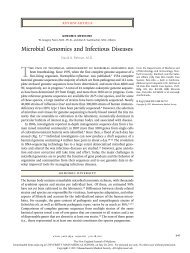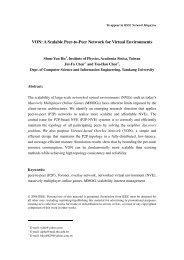366.7 KB - Evernote
366.7 KB - Evernote
366.7 KB - Evernote
Create successful ePaper yourself
Turn your PDF publications into a flip-book with our unique Google optimized e-Paper software.
Kernel mode waiting functions handle this case simply by setting<br />
_KTHREAD.ApcState.UserApcPending to 1 and returning immediately STATUS_USER_APC. Thus,<br />
the thread can immediately return to user mode and, in doing this, will deliver the APCs thanks to the<br />
set UserApcPending.<br />
The sample driver shows this in his ApcUserModeTest2 function, which confirms that, before<br />
attempting the wait, UserApcPending is clear, then when the wait function (KeWaitForSingleObject in<br />
this case) is called, it immediately returns STATUS_USER_APC and UserApcPending is found set.<br />
Conclusions on User APC Vs. Kernel Wait Functions<br />
The DDK help explains how waits initiated by kernel wait functions like KeWaitForSingleObject are<br />
not aborted for kernel APC: the APCs are delivered, if the right conditions apply, then the thread<br />
resumes its wait. On the other hand, the same documentation details how these wait functions abort<br />
the wait for user APCs.<br />
Now we understand why the wait is aborted: inside the wait function, the thread does not deliver user<br />
APCs. Instead, it returns from the wait function, so that the code following the wait can return to user<br />
mode, where the APCs will actually be delivered.<br />
This is probably done because it would be too complex to actually deliver user mode APCs while<br />
inside the wait function. After all, we are talking about user APCs, whose NormalRoutine must be<br />
called in user mode. The kernel would have to somehow switch to user mode, deliver the APC, then<br />
switch back to kernel mode and resume the wait function – not an easy feat.<br />
The implication is that kernel mode code (e. g. a driver) must “know” this, i. e. it must be written to<br />
handle the STATUS_USER_APC return code and the fact that it must actually return to ring 3 to allow<br />
user APCs to be serviced.<br />
On the other hand, kernel mode APCs can be delivered without aborting the wait functions, because<br />
they don’t require a switch from kernel mode to user mode.<br />
nt!KiDeliverApc for User APCs<br />
We are now going to see what happens when nt!KiDeliverApc is finally called for user APCs.<br />
First of all, we need to remember that it has three stack parameters: PreviousMode, Reserved and<br />
TrapFrame.<br />
When it is called for user APCs, PreviousMode is set to UserMode, i. e. 1, and TrapFrame points to a<br />
_KTRAP_FRAME structure storing the ring 3 context of the thread.<br />
The first part of nt!KiDeliverApc does the kernel APC dispatching, regardless of the value of<br />
PreviousMode. In other words, whenever this function is called, it dispatches kernel mode APCs if<br />
there are any, then, only if PreviousMode = UserMode, checks for user mode ones.<br />
All the actions explained in the section Delivery for kernel mode APCs are taken. If<br />
_KTHREAD.SpecialApcDisable is set, neither kernel nor user APCs are delivered.<br />
Also, if nt!KiDeliverApc finds regular kernel mode APCs to deliver and then finds either<br />
KernelApcDisable or KernelApcInProgress set, it stops delivering APCs and returns, without<br />
processing user APCs.<br />
However, when all the kernel APCs have been delivered and their list is empty, nt!KiDeliverApc sets<br />
to work on user APCs.<br />
27
















